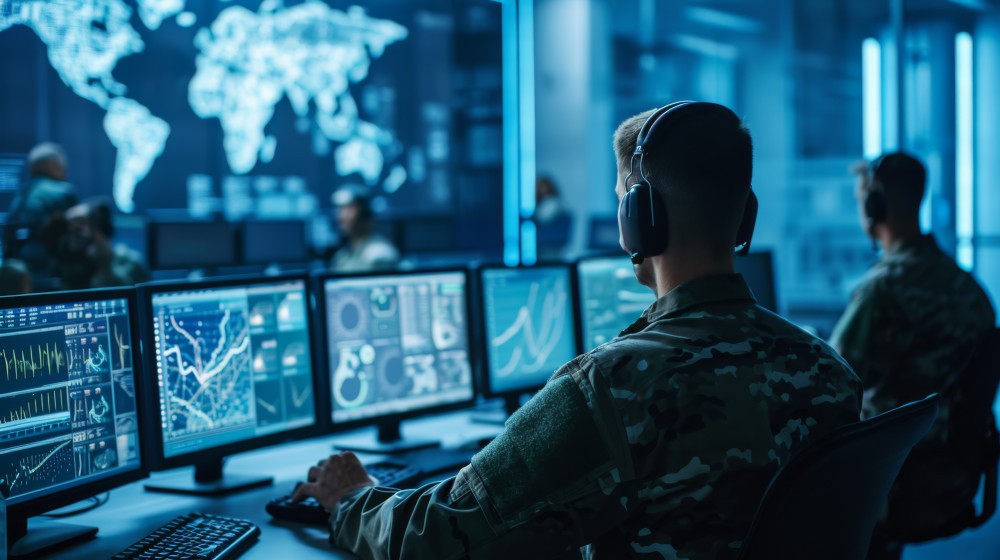Has artificial intelligence reached the defense sector?

Before answering this question, we should contextualize it a bit. Since cryptographic analysis during World War II, based on the concept of the Turing machine, to today’s advanced robotics systems, significant progress has been made in both the computational power and the algorithms behind the concept of artificial intelligence (AI).
As such, the use of AI in defense is nothing new, and although sometimes the technological breakthroughs are not as visible as in the civilian sphere, the use of AI is increasing the capabilities of military systems. It could be said that it is being adopted more gradually than in the civilian sphere, although the evolution of conflicts and the emergence of new information spaces make AI-based systems that support decision making and various data analytics processes increasingly necessary.
There have been many fields of application of AI in military systems for decades, although it was not until the 2000s that its use became widespread, largely due to the rapid evolution of information technologies. Some of the most relevant milestones for this technological revolution have been the following: the spread of broadband and high-speed Internet access; the evolution of mobile networks from 3G to 4G and now to 5G, which has increased the speed and capacity of data transmission and has enabled advanced applications; and the emergence of the concept of the cloud, which is transforming the way in which data is stored, processed, and accessed, allowing for unprecedented scalability and flexibility. Not to mention other, more specific breakthroughs in data processing, such as the development of deep neural networks that have enabled the evolution of machine learning systems; applications for image and voice recognition, natural language processing, automation, and autonomous navigation; and a host of other applications that have grown exponentially in recent years.
So far, I’ve been avoiding the concept of data intelligence systems, perhaps because it is one of the most abstract and broadest areas. Intelligence systems face new challenges every day, making it absolutely necessary for them to be able to analyze large volumes of data from a wide range of sources, with structured and unstructured information. To manage all this information and transform this huge amount of data into useful and usable information, we must develop tools that help us identify patterns and trends, as well as specific tools for data visualization. These data analytics platforms should, above all, enable more informed decision making. This is where multimodal technologies come in. These technologies are transforming how we interact with data, providing more intuitive and accessible interfaces that allow users to access the information as effectively and efficiently as possible, with tools such as interactive dashboards, virtual assistants, augmented reality, automated systems, and all other features that make it possible to reduce the time needed to search, check, or analyze data.
In the defense sector, these technologies have led to the creation of more advanced and efficient systems, from surveillance and reconnaissance to cybersecurity and military logistics. The operations area generates a large amount of information, and AI makes it possible to filter that data and obtain useful and more manageable information. AI and autonomous systems are transforming military operations, improving decision making and increasing threat responsiveness. As such, the military industry must continue to adopt civilian industry practices in relation to AI use to take full advantage of technological innovations and enhance capabilities.
However, there are some specific issues that must be addressed beforehand, such as the ethical, legal, and security challenges posed by the use of AI in defense. This refers to the concept of “Trusted AI,” that is, the development and use of safe, transparent, responsible, and ethical artificial intelligence systems. AI systems must be able to explain their decisions and processes must be auditable, and this requires establishing, among other things, a regulatory framework to guide the development and use of AI in defense applications.
At GMV, every day we see progress being made on various initiatives to boost the use of AI. Both the European Defense Agency (EDA) and the European Commission, through the European Defense Funds (EDFs), are working to define an overall strategy to strengthen Europe in security and defense matters through the use of innovative technology. EDFs provide significant funding for research and development projects, including those focused on emerging technologies such as AI. The fund is divided into two main components: the first is research through the support for R&D projects, where the EDF provides funding for collaborative research projects that develop innovative and breakthrough technologies in the defense field, with AI as priority area within these projects. The second focuses on the development of defense capabilities through prototyping, aimed at taking innovations from the research phase to practical implementation. As such, it funds initiatives to improve member states’ defense capabilities by integrating AI into existing systems, such as autonomous vehicles, drones, command and control systems, and more.
Which brings us back to the original question: has artificial intelligence reached the defense sector? And the answer is clear: it’s always been there, although it’s true that this technology is now more necessary than ever before. In the coming years, we’re sure to experience a major revolution in which traditional systems will have to coexist alongside the most disruptive technology. We’re convinced that AI has the potential to transform the defense sector, as evidenced by our ongoing active participation in the aforementioned European Union-led initiatives and programs in this field.
Author: Vicente Javier de Ayala